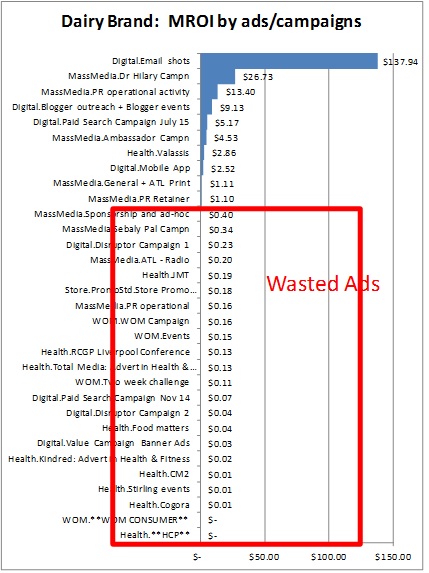“Half the money I spend on advertising is wasted; the trouble is, I don’t know which half.” John Wanamaker. Today’s post is written by guest-blogger, Michael Wolfe, CEO of Bottom-Line Analytics.
Identifying Poor Creative is Critical to Managing your Advertising Spend

Most of us can recite this famous quote by heart. As much as this is no longer true in this age of analytics and measurement, some people seem to still believe it so. For one, many companies still do not engage in active and robust measurement of all of their marketing activities. Perhaps, it might be because they are afraid of the shock to find out how much of their spending efforts have been wasted.
Various professional estimates of what percent of marketing spend is wasted range from 30 to as high as 60 percent. Some estimates and pronouncements have been downright depressing and shocking.
It is said that the effectiveness of marketing has reached an all-time low, according to a [2014] survey of 3,000 global marketers conducted by The Fournaise Marketing Group. The marketers surveyed reported that 65% of their marketing spend had no discernible effect on consumers. The report suggested the main cause of the waste can be largely attributed to lack of measurement.
Throughout my career and engagements, this has been a part of my focus in doing marketing-mix or ROMI models. I define “wasted spend” as any ad or campaign which yields less than “break-even” marketing returns.
The ranges I have seen are fairly broad. Recently, evaluating the ROI of ads and campaigns for a Dairy brand yielded weak results. Here, the story was not that flattering. As shown, 68% of the ads and 71% of the spend generated less than $.50 dollars per dollar spent.

Some cases, though not perfect by any means, do not look quite as grim. For example, for this gaming company, only 40% of the ads were below the ROI threshold and could be consider wasted spending.

How to Avoid Marketing Waste
From my various consulting experiences over the last 25+ years and seeing the differences shown here and across numerous other clients, here is what differentiates firms with a high proportion of “marketing waste” versus others who minimize this:
- Marketing ROI measurement. This is a discipline requiring support from the CEO all the way down the organization. Measurement is not meant to be a report-card, but rather a tool towards the aspiration of continuous improvement. As Peter Drucker once said: “You can not manage what you do not measure.” This is the first and most important step.
- Focusing on message and not just media channels. Marketing is an ongoing dialogue and communications exercise with customers. Knowing which messages work and don’t work is critical and measurement of message in the analytics exercise is essential. As part of this, better understanding what works and doesn’t work with ad creative is critical. This includes ensuring all your ads have an effective “call to action.”
- Ongoing copy testing and rotation of creative. I was recently introduced to a copy test company called Advertising Benchmark Index that has a very interesting visual of how it plots copy test scores for a brand. I call this the “worm chart” and it clearly displays high and low scoring ads in a clear and distinct way. When such tests are run in a clear and speedy fashion, companies can make a difference in their marketing effectiveness through effective rotation of the good for the not-so-good.

- While some companies clearly complain about the cost of doing this testing, auto owners spend as much as 5% of the value of their car on maintenance each year. Companies don’t spend anywhere near that on measurement and maintenance of their marketing and media. It’s time to get real. [note: ABX is the most cost-effective tool available. Rotating good for the not-so-good, as indicated by Michael, results in a positive ROI, so ABX becomes an investment not a cost].
- More effective companies tend to have less clutter and fewer total ads in their portfolio. In our case above, the company with high waste had 32 ads while the more effective company had 21. More ads mean more clutter and confusion as to your message. Keeping the message simple and consistent is key to improving overall effectiveness. Too many ads will yield a higher incidence of waste.
- Companies who are better at executing communications targeting towards their key customers have less ad waste. It goes without saying that communication targeting leads to more effective advertising, lower costs and higher returns to ad spending.
The Dilemma that all CMOs Must Address
The goal of having less waste and more effective advertising starts with the leadership of the CMO. Such leadership needs to put measurement at the center of its marketing efforts. A plan to generate more effective communications, more consistency and more simplicity, needs to be in place and be the top priority of the CMO’s endeavors. CEO’s need to demand this kind of leadership from their CMO and hold their marketing team accountable.

Michael Wolfe: CEO, Bottom-Line Analytics Global
Michael brings 30 years of direct experience in marketing analytics both on the client and consulting side. On the former, Michael has worked for Coca-Cola, Kraft Foods, Kellogg’s and Fisher-Price. He has also consulted with such blue-chip firms as AT&T, McDonald’s, Coca-Cola, Hyatt Corp., L’Oreal, FedEx and more recently Starbucks. Michael has broad experience in marketing analytics covering marketing ROI modelling, social media analytics, pricing and brand strategy.
mjw@bottomlineanalytics.com; 770.485.0270
Are you satisfied with your current creative effectiveness? Is it resonating through Awareness and Message, and having an impact on Reputation and Action? ABX provides the largest normative database in the industry across all media types. On average you can improve your creative effectiveness by almost 20%.
If you have questions about this article or how ABX can help your brand, contact us HERE.
